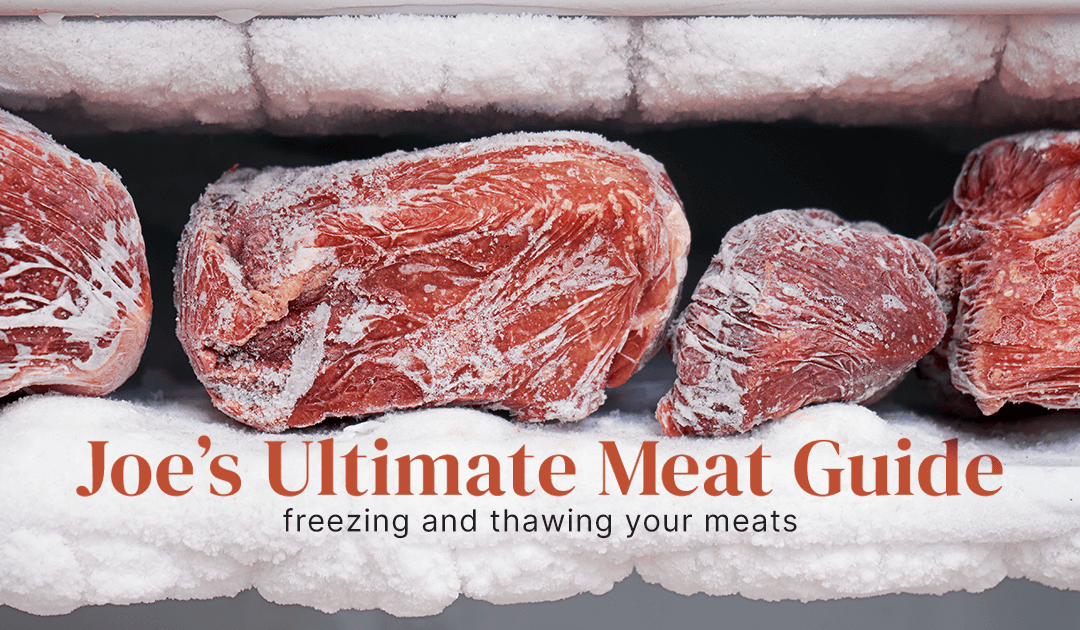We’ve been freezing and thawing meats from the day we got our very own place. Back then, I used to call a parent or family member with a long list of questions:
- How do you prepare meats for freezing?
- Do different meats require different freezing/thawing prep?
- How long can you keep frozen proteins in your freezer?
- What is the best way to thaw frozen proteins and how long can you keep them after thawing?
Given the number of questions we field on the topic, my guess is most of us recieved bad advice or just forgot what we knew. In this blog, I will attempt to answer these questions in as much detail as I can to give you the ULTIMATE guide to freezing, thawing and using meats.
That’s a wrap!
The enemy of every piece of frozen meat is air. Your goal should be to protect the meat as much as possible from freezer burn and contact with air. Freezer burn is essentially evaporation under very cold conditions (yes, water can still evaporate at below freezing). Those discolored spots on freezer burned food are from uneven evaporation caused by contact with the air as well as too much time being frozen. Air contact will also bring a funky flavor accompanied by that generic frozen smell.
- The best way to protect your meats is to ask Joe’s to vacuum seal anything you plan to freeze. Vacuum sealing removes all of the air surrounding the meats and encases them in a thicker film that will resist harsh freezer treatment and tempuratures. At Joe’s, we vacuum seal the first three items in a purchase for free, and after that, charge $0.45 per bag/item in order to seal the remainder of your purchase. Admittedly, this requires a bit of advance planning on your part. It’s best to call (317-846-8877) or email orders@joesbutchershop.com a day in advance and be as specific as possible as to how you want each of your products wrapped. Some customers have small vacuum sealers at home, which is also a fine way to seal your meats for freezing. However, our commercial sealers provide more air removal and thicker bags to protect your meats.
- The second-best way is to use a freezer-weight zipper-style bagwith as much air removed as possible. You can do this with a straw in the last unsealed portion of the bag’s zipper … literally suck the air out and quickly seal that last bit. If inhaling raw meat air offends your sensibilities and seems unsafe, you can use water displacement. To do this, place the bag in a vessel of water, submerge it to just below the zipper (this will force out most of the air), seal and dry the bag off.
- The third-best choice is to let our associates know that you will be freezing your meats so we can wrap them in our freezer paper. We use a high quality “freezer paper” that is coated on the interior to allow maximum contact with your meats. By letting our associates know you are freezing your meats, they will be sure to not wrap items loosely as they would for shorter term refrigerator storage.
- The final choice is to wrap meats tightly in plastic film followed by a snug layer of foil. You can even throw in a layer of parchment or wax paper between the two for a little extra protection.
Different strokes for different folks!
In general, beef, chicken, pork and fish are all frozen the same way. The key is freezing each meat seperately. It’s vital to not freeze several pieces of meat together because it creates air pockets. For example, if you have four chicken breasts, freeze them individually, not all in one clump.
One thing to take into consideration is if your meat contains a bone. When we vacuum seal meats, we cover the bone so that it does not break through the bag and compromise your seal. At home when freezing, it’s always wise to give a second wrapping to any exposed bone on your product to avoid the same issue.
Does anybody really know what time it is?
Different meats will last shorter or longer based on the type of meat (beef, chicken, pork or seafood) and the method you use to wrap (1 – 4 above). Here’s a guideline to go by: on all meats, methods three and four will last shorter and methods one and two will last longer.
Poultry: 3 to 9 months (vacuum sealed whole birds like turkeys last the longest. Cuts such as breasts and thighs last five months).
- Ground Meats (all types beef, pork or poultry, including sausage): 2.5 to 4 months.
*Why the short time on ground meats? Even frozen meat has bacterial action going on, though greatly reduced compared to fresh. Ground meats have more surface area and therefore, higher bacterial action while frozen. - Beef, Pork Lamb, Veal (steaks, chops, and roasts): 4 to 12 months
- Bacon, Hot Dogs, and Ham: 1 month (the curing of these does not lend itself to great freezing—more so from a quality/flavor standpoint than bacterial concerns)
- Fatty Fish (catfish, tuna, salmon, etc.): 2-3 months
- Lean Fish (cod, halibut, sole, etc.): 4 to 8 months
- Live Shellfish (clams, mussels, lobster): Just don’t do it!
- Fresh Shellfish (lobster meat, crab, mussels, scallops, etc.): 2 to 4 months
- Soups and Stews: 2 to 3 months
- Cooked foods: 1 to 3 months
- Eggs (Never whole, but only beaten whites and yolks together): 11 months
If there comes a little thaw, still the meat is raw!
The best and safest way to defrost meat is overnight in the refrigerator, until the meat is completely thawed. If you thaw meat in the refrigerator, you can freeze it again safely for one month. We do not recommend it from a quality standpoint, as all meats suffer at the hands of those who re-freeze! Better yet, cook the meat the way you want and then freeze it for one to three months.
Let’s face it—sometimes you don’t have overnight to thaw. Here are the next best methods when you do not have the time to thaw as directed above:
- Water Bath (one hour): If your meat is vacuum sealed or freezer bagged, you’re in good shape. If not, place your frozen cut of meat in a resealable plastic bag, squeezing out as much air as possible. Fill a large bowl with cold water and submerge the bag in the water. Change the water every 30 minutes to ensure it stays cold and continues to thaw the meat. Smaller cuts of meat, poultry or seafood (about a pound) can thaw in an hour or less, larger quantities (3 to 4 pounds) may take 2 – 3 hours. Estimate about 30 minutes per pound for whole frozen turkeys.
- Microwave (as short as 10 minutes): It’s a bit of trial and lot of error on learning how to defrost meat in the microwave. This method works best for smaller cuts of meat that will be cooked all the way through after thawing, like chicken breastor ground beef for tacos. Read up on your microwave’s instruction manual to learn the best way to defrost a specific cut of meat according to the its settings. If your microwave doesn’t have a “defrost” setting, set it at a lower power level and run it in short bursts until the meat is thawed. Be careful though, cooking at too high a heat or for too long can cook the meat instead of defrosting.
Don’t just do it….
The internet will tell you that thawed raw meats are good in your fridge for anywhere from 2 to 5 days. Joe’s advice is, “just don’t do it.” Cook all thawed meats withing 24 hours of complete thawing. It’s safe and reliable. Don’t have time to make the tacos right away? Sauté or fry your ground beef unseasoned and keep it in the fridge for a few days so you can reheat and season it later. Not quite ready to grill that steak or chop? Sear it well and put it back in the fridge to finish later. The majority of the bacteria live on the surface of the cut, so you can gain a day or two this way. It’s better than throwing out raw thawed meat and way better than risking a food borne illness.

